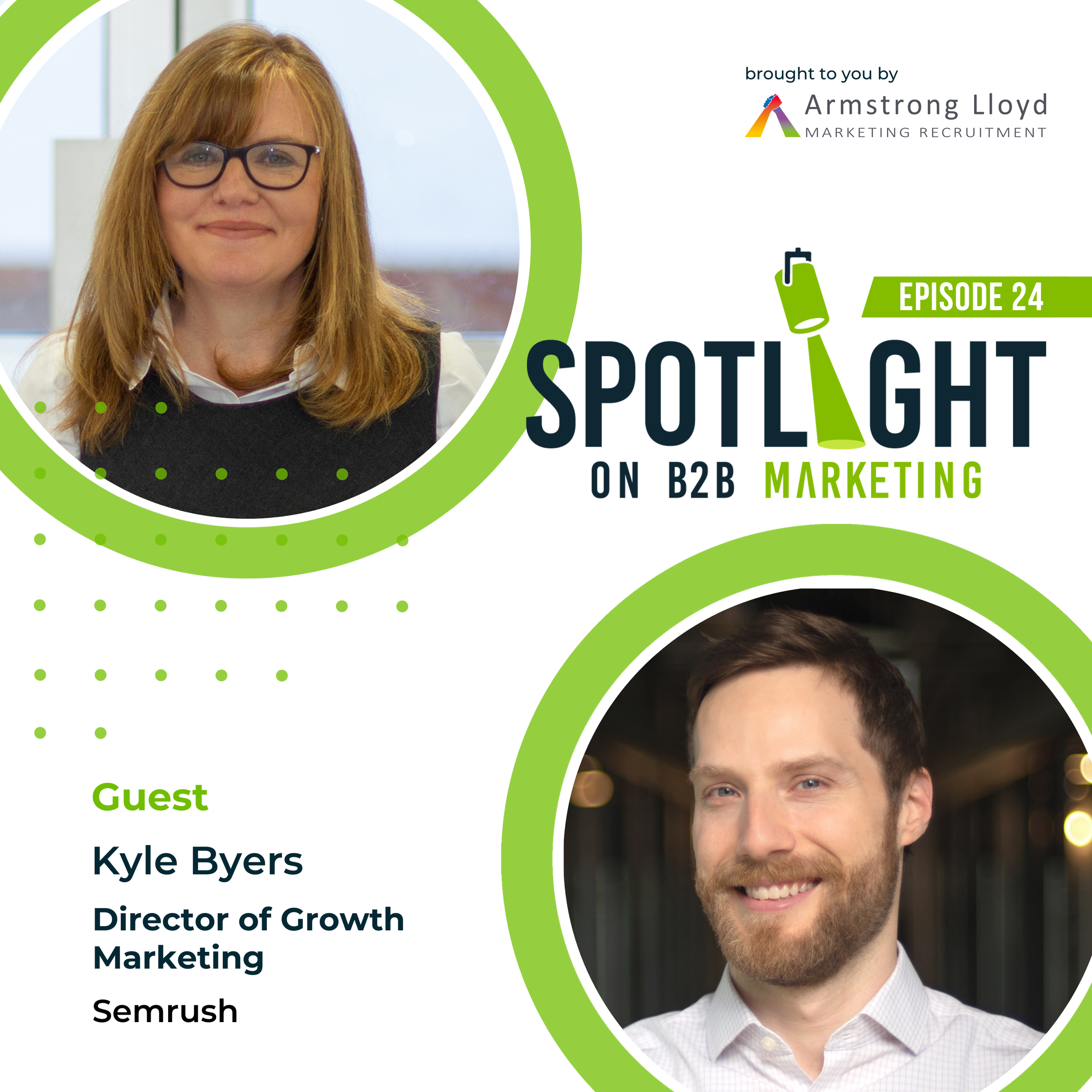ADAPTING TECH MARKETING STRATEGIES IN A CHALLENGING ECONOMY
Welcome to the Spotlight on B2B Tech Marketing, brought to you by Armstrong Lloyd.
In this episode, host Karen Lloyd sits down with Ross Chapman, a seasoned marketing leader with over 16 years of experience driving revenue growth for B2B SaaS technology companies including Aptitude Software and PortSwigger.
Join us as Ross shares his insights on how to adapt tech marketing strategies in today's challenging economy. Together we delve in and discuss the importance of customer-centric approaches, the efficient use of available resources in times of tight budgeting, and the importance of a commercial outlook for all marketers.
EPISODE OUTLINE AND HIGHLIGHTS
[00:00:31] Introduction and Guest Background
[00:00:54] Influential Marketing Books
[00:03:11] Biggest "Aha" Moment in Marketing Leadership
[00:06:15] Marketing's Role in Business Growth
[00:09:08] Understanding Customer Needs
[00:11:41] Educating Stakeholders on Marketing Importance
[00:15:34] Sales and Marketing Partnership in Enterprise
[00:21:28] Challenges in Technology Marketing
[00:24:21] Marketing Budgets and Delivering Value
[00:28:20] Future Predictions for Technology Marketing
[00:30:16] Hiring Trends in Marketing
REFOCUSING ON CUSTOMER VALUE IN A COMPETITIVE MARKET
The last year has been a challenging one for most in tech and has required marketers to adapt, pivot and respond. Ross and Karen delved into the need to refocus marketing efforts on delivering genuine value to customers and several key strategies emerged:
Understanding Customer Needs
Ross advocates for structured research methods, particularly referencing Adele Revella's buyer persona approach. Your research should uncover five key "rings of buying insight," helping marketers understand the customer's context, challenges, and decision-making process. Ross shares examples from his experience at Aptitude and PortSwigger, where this approach significantly changed their digital strategy.
Shifting from Company-Centric to Customer-Centric Content
Karen and Ross critique the overuse of traditional promotional tactics like generic webinars and newsletters. Ross recommends focusing on content that answers customers' questions and helps them do their jobs more effectively. He references the book "They Ask, You Answer" as a guide for this approach. He emphasizes that valuable content builds trust and engagement before customers even fully understand the product offering.
Leveraging Community-Building Tools
Ross discusses the effectiveness of building communities around shared customer challenges. He suggests using roundtable events to facilitate peer-to-peer learning and networking. The strategy of helping customers build business cases for solutions is highlighted as a way to provide value beyond the product itself.
By implementing these strategies, Ross and Karen explore how companies can create meaningful differentiation in a challenging market. This customer-centric approach not only helps in acquiring new customers but also in retaining and growing existing relationships, which is crucial in a tight economic environment.
ALIGNING TEAMS FOR EFFICIENT GROWTH IN RESOURCE-CONSTRAINED ENVIRONMENTS
Recognizing that many tech companies are facing budget constraints, Ross and Karen outline strategies for maximizing marketing impact with limited resources:
Creating a Shared Understanding of Growth Opportunities
Ross emphasizes the importance of aligning sales, marketing, and product teams around a common vision of growth opportunities. He suggests creating a written, agreed-upon list of top growth opportunities organized by customer segment. This alignment helps prevent the common pitfall of marketing teams from becoming overwhelmed by tactical requests without driving real revenue growth. By having this shared understanding, teams can focus their limited resources on the most promising areas for business growth.
Developing a Comprehensive Customer Journey Map
A strong advocate for mapping the entire customer journey, Ross discusses how this map serves as a tool to align all teams around delivering value at each stage of the customer experience. He shares an example from his experience at Port Swigger, where the lack of a shared customer map led to misalignment between marketing efforts and product value delivery. By understanding the full customer journey, teams can identify key touchpoints where they can make the most impact with limited resources.
Focusing on High-Impact, Low-Cost Activities
In resource-constrained environments, Ross recommends prioritizing activities that demonstrate deep customer understanding and build trust. These might include creating insightful content that addresses specific customer pain points, hosting targeted roundtable discussions, or developing tools that help customers make business cases for solutions. He argues that these activities can often yield significant results without requiring large budgets.
Balancing Technology and Advertising Spend
While acknowledging that some investment in marketing technology and advertising may be necessary, Ross emphasizes that small marketing teams can make a significant impact by prioritizing customer understanding and cross-functional alignment. He suggests that by deeply understanding customer needs and aligning teams around these insights, companies can often achieve better results than through large-scale, untargeted advertising campaigns.
Through these strategies, Ross illustrates how marketing teams can drive significant growth even in resource-constrained environments. The key lies in prioritising deep customer understanding, cross-functional alignment, and focused efforts on high-impact activities.
If you are interested in any of the books discussed in this episode, full details are below:
Crossing the Chasm; Marketing and Selling Disruptive Products to Mainstream Customers, Geoffrey Moore
Buyer Personas, Adele Revella
They Ask, You Answer; A Revolutionary Approach to Inbound Sales, Content Marketing, and Today's Digital Consumer, Marcus Sheridan
Sales Pitch; How to Craft a Story To Stand Out and Win, April Dunford
Obviously Awesome; How to Nail Product Propositioning so Customers Get It, Buy It, Love It, April Dunford
The Obstacle is the Way, Ryan Holiday
Forget the Funnel; A Customer-Led Approach for Driving Predictable, Recurring Revenue, Georgiana Laudi & Claire Suellentrop
TODAY’S GUEST
Ross Chapman is a vastly experienced senior Marketing leader with a strong background in helping SaaS businesses to achieve sustainable growth; Aptitude Software from £7 million to £50 million and PortSwigger from £15 million to £40 million.
With a background in engineering and sales, and trained by Mark Ritson, Ross brings a unique perspective on bridging the gap between marketing, sales, and product teams to drive customer-centric growth.
You can connect with Ross on LinkedIn.
OUR HOST
Karen Lloyd is a passionate marketing headhunter and recruitment expert specialising in marketing and C-suite in the technology sector. With over 25 years of experience in the recruitment industry, Karen brings a unique depth of expertise that sets her apart from most recruiters.
Over her career, Karen has accumulated a wealth of experience that includes serving as a Board Director and being actively involved in growing a business for 13 years. Karen has been a part of five start-ups, giving her first-hand knowledge of the critical importance of hiring the right people.
Currently, Karen is the founder and Director of Armstrong Lloyd. She leads a very special team that partners with businesses and empowers them to build industry-leading marketing teams for some of the most exciting B2B technology brands - from small agile and disruptive start-ups to global giants providing a wealth of product and service offerings.









